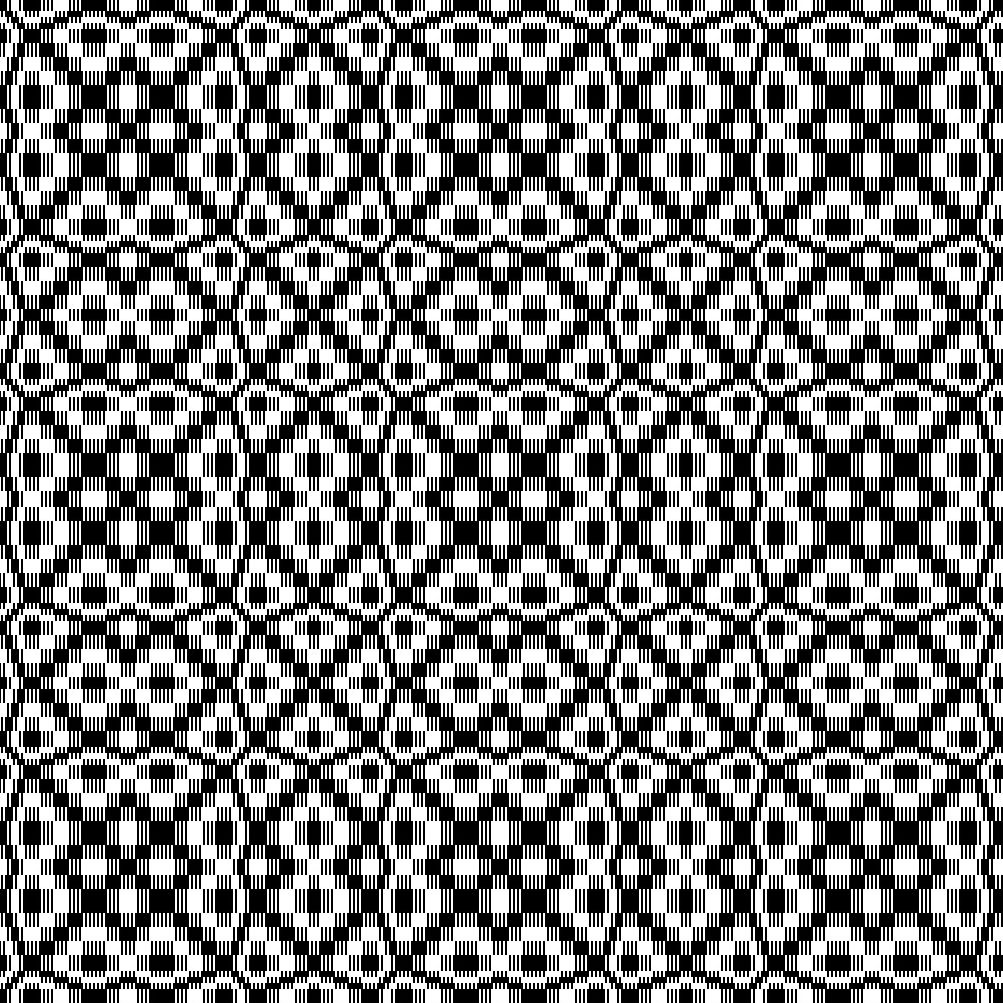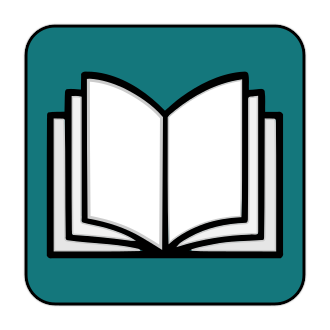Namedrafting is a technique for coming up with original designs that’s been around for ages. It’s most often used to design new overshot threadings, though it can be used in many other ways as well.
In its most typical form, it’s a system for associating each letter of the alphabet to the shafts on a loom – what’s called a mapping – and then “spelling out” words like names or phrases in the threading.

You can associate the letters with specific shafts in any way you choose; the most commonly used mapping simply assigns each letter in alphabetical order, like so:
Shaft 1: a, e, i, m, q, u Shaft 2: b, f, j, n, r, v Shaft 3: c, g, k, o, s, w Shaft 4: d, h, l, p, t, x y z
I’ve lumped x, y, and z all onto Shaft 4 together since neither x nor z comes up that often, but another common choice is to put x on Shaft 4, y on Shaft 1, and z on Shaft 2.
I call this the ‘aeimqu’ mapping, which is the set of letters across the top line (that is, the letters assigned to Shaft 1). That’s not a label you’re likely to see anywhere else! Most people don’t bother naming this mapping at all but I play with so many different mappings that I find it useful to be able to refer to them by name.
Note that this version of the AEIMQU mapping doesn’t tell you what to do with punctuation or numerals. If your phrase doesn’t contain either one, then that’s no problem. If it does, you need to decide how to assign those to the shafts as well.
Once again, any choice you make is a good one: namedrafting is a stepping stone to your original design, not an ironclad set of rules you must follow. Use the “rules” you like, change or ignore the ones you don’t; any choice you make simply makes the design more yours.

Deriving an overshot threading
Once you’ve got a mapping, you can use it to spell things out. Simply write out a word or phrase and replace each letter with the number of the shaft it’s mapped to…
O V E R S H O T 3 2 1 2 3 4 3 4
…and then use that as a threading repeat, like so:

Easy, right? Well, yes, it IS easy, but the word ‘overshot’ is an unusual example in that, once mapped to shafts, the numbers always alternate odd and even. If you’re familiar with overshot, you’ll know that’s a requirement of an overshot threading.
If the letters in your word or phrase don’t alternate odd/even once converted into shaft numbers (and you’re planning to use the threading for overshot), you’ve got to deal with spots where two odds or two evens land side by side – including at the repeats. Take the name Janet, for instance:
J A N E T 2 1 2 1 4
It also happens to alternate odd and even, but once repeated the 2 at the end of one repeat and the 4 at the start of the next are side by side (see the orange arrows).

What to do with the glitches in the odd/even matrix is up to you. You can insert an odd between two evens or an even between two odds, you can take out one of the odds or evens, etc. You needn’t do the same thing every time, either: each spot where two odds or two evens land side by side is a choice you need to make, and you can make a different choice each time.
Once you’ve dealt with the glitches, you’ve got a viable overshot threading. To weave it as overshot, though, you also need a treadling. The obvious choice for the treadling system is traditional overshot: alternating one pattern pick with one tabby pick. The obvious choice for the treadling block order is star fashion: as-drawn-in block by block rather than thread by thread.
Those are just two more choices, though. Any choice you make just makes your design more original, so feel free to use a different block order or treadling system if you know how.
Deriving a star fashion liftplan
To derive the star fashion shed order for overshot is fairly simple, particularly if you create a liftplan. Here’s how to determine which sheds the pattern weft should go through:
Starting with the first two warp ends at the right selvage:
- Look to see which two shafts the two warp ends are on.
- Lift the other two shafts for the next weft pick, so that the pattern weft will float over those two warp ends.
- Move ONE THREAD to the left, so that the new pair consists of a new thread plus its neighbour to the right, which was also in the previous pair.
Repeat 1-3 all the way across the threading and you’ll have a star fashion liftplan. (You could start at the left selvage and work to the right instead, of course – just pick one side and work away from it.)
Here’s a demo using the threading above for the word ‘overshot’:
Once you’ve got a liftplan, you can convert it to a treadling and tie-up[HA] if you like, and from either liftplan or treadling and tie-up you can make a drawdown.[HA] Remember: this liftplan and the resulting drawdown is only for the pattern weft. You’ll still need to “use tabby”.[HA]
You can find these instructions in the Weaver’s Toolbox too, in the Drafts and Drafting category.[HA]
This is the version of Namedrafting most familiar to weavers. It rarely produces recognizable colonial overshot motifs like wheels, stars, roses, etc. Instead, it produces small, hybrid patterns that mix overshot with twill. The pattern floats are shorter and interlace with the fabric more, which means it usually likes a slightly more open sett compared to larger scale overshot.[HA]
You can find loads of examples of this style of Namedrafting. My personal favourite is the book Weaving Designs by Bertha Gray Hayes: Miniature Overshot Patterns by Norma Smayda.
Namedrafting variations
This most common version of namedrafting is just the tip of the iceberg, however. You can
- Use a mapping other than AEIMQU
- Map to something other than shafts
- Map from something other than letters – music is a popular choice
- Use namedrafting to design a profile threading
- Use the threading for something other than overshot
- Use namedrafting to design a treadling, profile or otherwise
- Use namedrafting to design something other than a threading or treadling
There are so many possibilities that I can barely squeeze the highlights into a two hour presentation!
My Namedraft generator
As I said, I play with namedrafting a LOT. It appeals to me particularly because of its very logical algorithm, which is the perfect crossover between my weaving brain and my computer science/programmer brain. In fact, I wrote a browser based Namedraft Generator that takes a phrase you input, uses the mapping you choose and some other settings you can play with, and produces a threading and its star fashion treadling which you then can download as a .wif and upload into the application of your choice.
The generator has more mappings than just AEIMQU; it also has the option to map to blocks or motifs instead of shafts. It also lets you produce a profile threading and treadling rather than a structural one if you want to use them for something other than overshot. So far it only starts from an alphanumeric phrase and only produces a threading and treadling, but someday I might add other options. You know, in my free time. ;)
This generator is where my Undaily Namedrafts[HA] all begin. I play around with the mappings and other options and open each .wif up to see what it looks like. I usually do some combination of mirroring it, reversing it, repeating it, etc. I pick out parts I like and might emphasize those in some way. If there are parts I don’t like, I either take them out completely or alter them in some way. I might add color or I might not. In short, I mess about with whatever the generator gave me and see where I wind up.
The whole point is to create an original design that you like, so any and all changes you make to what the generator spits out are fair game! Just keep in mind the rules for whatever structure you intend to use, such as overshot’s odd/even rule.

From the Weavers Toolbox:
From the course The Secrets of Liftplans, Treadlings, and Tie-ups:

“Use tabby” – How to understand and carry out the instruction to “use tabby”
From the course Drawdowns, Part 1: Structural Drawdowns:

Creating a drawdown from a draft – How to create a drawdown from a threading and shed diagram

Designing with Drawdowns – Using the information in a drawdown to figure out an appropriate sett
From the Community:

The Undaily Namedrafts thread in Let’s Talk Weaving


